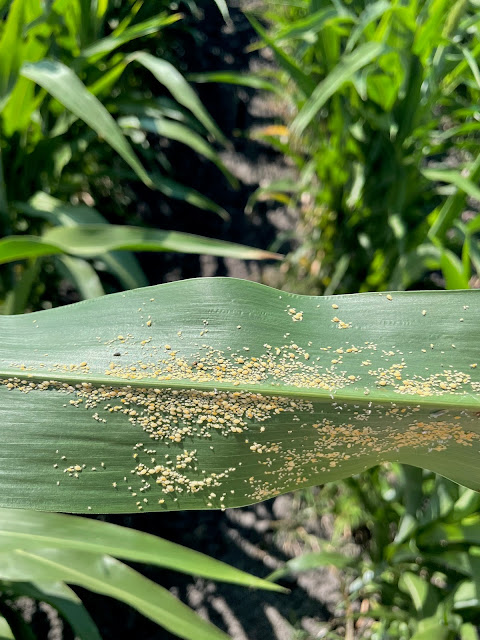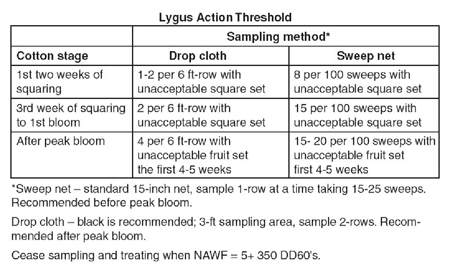Howdy,
Next Monday is the Jackson County Ag Tour. The tour will start at the sorghum demonstration at 4:00 pm. Please contact the Jackson County Extension office with any questions on that program.
In sorghum we need to be scouting for sugarcane aphid, those are building with the drier weather. I've picked it up in sorghum in all three counties, and there are fields that reached threshold for it already. If it's blooming, we need to look for sorghum midge. Here are some links for just sugarcane aphid, and a more recently updated guide for sorghum insect management. Here are links to the threshold calculators for sorghum midge, rice stink bug, and sorghum headworm. I am picking up low numbers of headworms and rice stink bug right now.
 |
| Sugarcane Aphids in Sorghum Kate Crumley |
The aphids in cotton have started to crash this week, there are still a couple fields with low numbers, but I'm not seeing the large populations we were last week. We are still picking up fleahoppers, and need to be scouting anything not blooming yet for those. This week we started picking up bollworm eggs and very light damage on some of our smaller fruit, and neonate worms in the fields we found worms. There are also scattered lygus bugs and verde plant bugs below threshold in a few places in all three counties. I've found some, and I've heard from several consultants that there are lygus and verde plant bugs out there. We did scout for stink bugs as well, but only found three adult brown stink bugs in one field location near Wharton. Below is my scouting information for the week of 6/9/2022.
 |
| Cotton Aphid Kate Crumley |
The threshold for cotton aphids is 50 aphids per leaf, and if you see aphid mummies in the field (tan or black dry and unmoving aphids), that's a good thing. Parasitoid wasps lay eggs in the aphids, and the aphid forms a mummy while the wasp larvae is pupating inside. These wasps, lady beetles, and lacewings can knock back aphid populations. Treatment for aphids is rarely justified, but I have seen some cotton at threshold this year. If you do decide to treat for aphids, do not use a pyrethroid. Pyrethroids and organophosphates are broad spectrum, and kill beneficial insects as well as your target insect, but pests like aphids bounce back much quicker than their predators do. Their high reproductive rate will allow their numbers to soar after a broad spectrum insecticide application kills all their predators.
 |
| Aphid Mummies on Cotton Kate Crumley |
 |
| Cotton Fleahopper Adult Kate Crumley |
Fleahopper feeding will cause squares to drop. Plants can recover for and compensate for some square loss, but the threshold for fleahoppers is 15-25 per 100 plants. I check for fleahoppers by inspecting the plant terminals once they start squaring. I look at 25 plants per stop in the field, usually checking 100 plants total in an 80-100 acre field, more if the field is larger. Fleahopper nymphs can be close to the size of aphids, but look like smaller versions of the adults without wings, and are much more mobile than aphids.
The chart below contains insecticide suggestions from cottonbugs.tamu.edu (also a good resource) for reference if you have fleahoppers at the action threshold in the upcoming weeks.
 |
| H. zea Larvae Kate Crumley |
Our Bt traits overlap across corn and cotton. If the caterpillars survive the traits on corn then as adults fly to cotton to lay eggs, it's likely their offspring will survive the same traits on cotton. Below is a chart showing the overlap of Bt traits between crops and technologies.
 |
| H. zea Eggs on Cotton Kate Crumley |
 |
| Evidence of Sucking Insect Damage on Cotton Boll Kate Crumley |


I'd also like to let everyone know that there is an Agricultural Pesticide Waste Collection event happening on Wednesday, June 29th from 8:00 am to 12:00 pm at the Victoria County Pct #4 Yard at 226 Beck Road East, Inez, TX 77968. The flyer for that event is below. For any additional questions on this event, please contact the Victoria County Extension Office at (361)-575-4581.
Please check out our weekly IPM Audio Updates, the website to sign up to receive those is listed below. If you have any questions feel free to contact me either by email or calling the office. Have a good weekend, everyone!
Sincerely,
Kate Crumley
Check out our weekly IPM Audio Updates
Cotton Insect Management Guide
Development and Growth Monitoring of the Cotton Plant














No comments:
Post a Comment